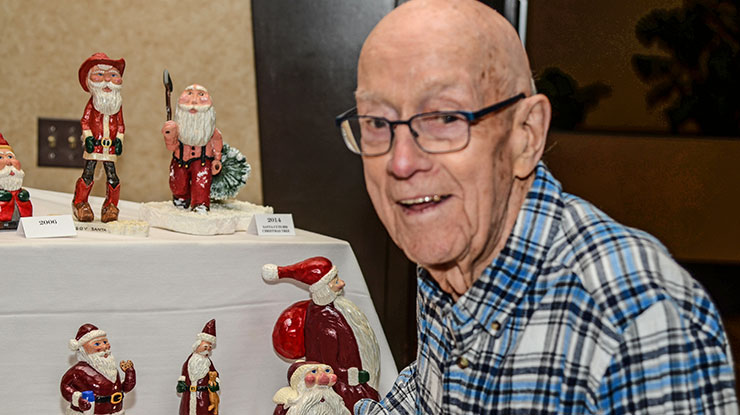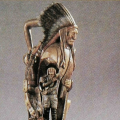Woodcarver Jack Nitz of Tulsa, Okla., has proven that one person really can make a difference. His inspired idea for an eagle-head cane project spawned a program that has enlisted thousands of woodcarvers nationwide to support and honor U.S. veterans who have suffered leg disabilities due to combat since September 11, 2001.
The idea began one cold January night back in 2004, when Jack watched a television news segment about wounded post-9/11 veterans. He noticed that many of the veterans suffered from serious leg wounds and even leg amputations. Visions of those injured veterans weighed heavily on Jack’s mind. Then, an idea struck. “I realized there was a little something that I, as a woodcarver and cane maker, could do to show my respect and support for these young people,” said Jack.
A longtime member of the Eastern Oklahoma Woodcarvers Association, Jack had been working for several years to perfect a basswood eagle-head cane design. He thought the cane would be a perfect tribute to injured veterans. Jack showed the sample cane to his woodcarving group, who were all impressed with the design and workmanship. “I was excited because I knew our group had been looking for a project we could really get behind,” Jack explained.
Jack proposed the Eastern Oklahoma Woodcarvers Association carve commemorative eagle-head canes for injured veterans as their club project. The group heartily backed the idea and began the Eagle Cane Project to make canes for veterans who have suffered a leg, foot, hip, or related injury in combat since 9/11.
To keep the canes consistent, Jack passes out patterns of his eagle-head cane design to all who want to participate. “I had initially designed an eagle-head cane that included a carved flag wrapped around the shaft. I used this design minus the flag for the pattern because the flag takes a lot of time to carve,” he explained. “There is always a trade-off between functionality and realism or artistic license. I wanted to make the cane usable for all the occasions where the veteran might wish it for dress wear, and still have it be as realistic as possible.”
When word got out about the Eagle Cane Project, clubs around the country started contacting Jack and his group, volunteering their help with the project. Today, hundreds of woodcarving clubs in forty-eight states have taken on the popular project. Some clubs have provided cane stands as well. The Oklahoma group even has woodturners who make some of the cane shafts for the project.
“We thought it best to allow the various clubs flexibility to adapt the project to the needs of the veterans in their states. A few clubs have broadened their interests under new names to include all veterans as part of the overall effort. But we caution them not to bite off more than they can chew,” said Jack.
Although Jack has no idea how many eagle canes have been presented nationwide, the Michigan Woodcarvers Association has kept count of their presentations, which include World War II veterans. “To date, our forty-four carving clubs, with about 1,400 members, have presented more than 1,000 canes to veterans across the country,” said the group’s president, Andrew Luckhardt.
The Eagle Cane Project invites all post-9/11 veterans who have suffered a leg injury in Iraq or Afghanistan to accept a handcarved, personalized eagle-head cane honoring their service and sacrifice. Clubs locate potential recipients through non-profit organizations, such as Soldiers Angels, the Patriot Guard Riders, and the Blue Star Riders. Participating clubs are encouraged to send representatives to local VA hospitals to seek qualified veterans.
“I hope people take the time to visit the website and read the stories of the veterans. We share the veterans’ comments about their canes and how they felt about receiving them,” said Jack. “Some of their testimonials are very moving.”
For more information about the Eagle Cane Project, including tutorials, testimonials, and a list of participating clubs, visit www.eaglecane.com.
Attachments:







